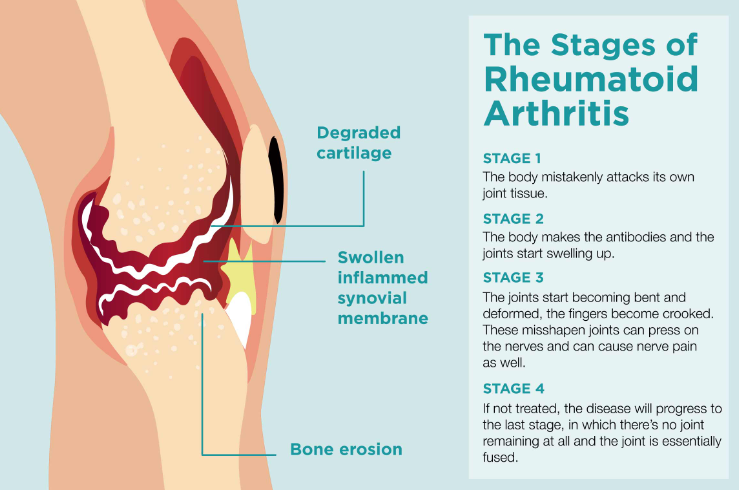BOURSESSENEGAL – Rheumatoid arthritis (RA) is a chronic inflammatory disorder that primarily affects the joints. Understanding what are the 4 stages of rheumatoid arthritis can empower individuals to manage their symptoms and seek appropriate treatment. In this post, we’ll delve into each stage, explore its characteristics, and discuss how they impact daily life.
What Is Rheumatoid Arthritis?
Before diving into the stages, it’s essential to grasp the nature of rheumatoid arthritis. This autoimmune condition occurs when the immune system mistakenly attacks the synovium, the lining of the membranes that surround the joints. This leads to inflammation, pain, and eventual joint damage. RA can affect more than just the joints; it can also impact various organs throughout the body, making early diagnosis and treatment crucial.
The 4 Stages of Rheumatoid Arthritis
Understanding the progression of RA is vital. The disease typically progresses through four stages: initial stage, moderate stage, severe stage, and end-stage. Each stage has unique characteristics and implications for treatment.
Stage 1: Initial Stage of Rheumatoid Arthritis
Symptoms and Characteristics
In the initial stage of rheumatoid arthritis, patients often experience mild symptoms. These can include:
- Joint pain and stiffness: Typically worse in the morning or after prolonged inactivity.
- Fatigue: Many individuals feel unusually tired.
- Mild swelling: Joints may show slight swelling, particularly in the hands and feet.
During this phase, the inflammation is localized. Although the symptoms may seem manageable, early intervention is critical.
Importance of Early Diagnosis
Recognizing these symptoms and seeking medical advice can lead to early diagnosis. Healthcare providers may recommend blood tests and imaging studies to confirm the presence of RA. The sooner you receive a diagnosis, the more effective treatment can be.
Stage 2: Moderate Stage of Rheumatoid Arthritis
Symptoms and Characteristics
As RA progresses to the moderate stage, symptoms become more pronounced. You may experience:
- Increased joint pain: Discomfort becomes more consistent and may affect daily activities.
- Joint damage: Imaging studies may reveal erosion or changes in bone structure.
- Fatigue and weakness: Increased systemic inflammation can lead to a feeling of overall weakness.
At this stage, patients often find it challenging to perform simple tasks, like holding a pen or climbing stairs.
Treatment Options
During this phase, doctors may prescribe disease-modifying antirheumatic drugs (DMARDs) to slow down disease progression. These medications help reduce inflammation and prevent further joint damage. Physical therapy may also be recommended to maintain mobility.
Stage 3: Severe Stage of Rheumatoid Arthritis
Symptoms and Characteristics
In the severe stage of rheumatoid arthritis, the impact on the body becomes more profound. Key symptoms include:
- Persistent joint pain: Pain may be constant and debilitating.
- Significant swelling and inflammation: Joints are visibly swollen, and movement may be restricted.
- Deformities: As the disease progresses, joint deformities may develop, particularly in the hands and feet.
The quality of life often diminishes significantly during this stage. Many individuals may struggle with simple daily tasks.
Advanced Treatment Strategies
At this point, treatment strategies may involve more aggressive approaches. Biologic medications, which target specific parts of the immune system, may be introduced. These can provide substantial relief and help manage symptoms effectively. Occupational therapy can also play a vital role, assisting individuals in adapting their environments to make daily activities easier.
Stage 4: End-Stage Rheumatoid Arthritis
Symptoms and Characteristics
The end-stage of rheumatoid arthritis represents a critical juncture in the disease. Patients may experience:
- Chronic pain: Pain becomes a constant presence.
- Severe joint damage: Joints may be irreversibly damaged, leading to significant mobility issues.
- Systemic effects: Other organs may start to be affected, complicating health further.
In this stage, many patients may face the possibility of joint replacement surgery or other invasive interventions.
Palliative Care and Support
At this point, palliative care becomes crucial. The focus shifts to improving quality of life rather than aggressive disease management. Pain management strategies, physical therapy, and psychological support play a critical role. Support groups can provide a sense of community and understanding during this challenging time.
Living with Rheumatoid Arthritis
Navigating life with rheumatoid arthritis can be challenging, regardless of the stage. Here are some strategies to help manage your condition:
Stay Informed
Educate yourself about RA. Understanding what are the 4 stages of rheumatoid arthritis allows you to recognize symptoms early and advocate for your health.
Maintain Regular Check-Ups
Regular visits to your healthcare provider can help monitor the disease’s progression. This proactive approach allows for timely adjustments in treatment.
Incorporate Physical Activity
Gentle exercise can help maintain joint flexibility and reduce stiffness. Activities like swimming, yoga, and walking can be beneficial.
Build a Support System
Surround yourself with supportive friends, family, and healthcare professionals. Emotional support is essential for managing chronic conditions.
Nutrition Matters
Eating a balanced diet rich in anti-inflammatory foods can help. Foods such as fatty fish, nuts, fruits, and vegetables can contribute to overall well-being.
Conclusion
Understanding what are the 4 stages of rheumatoid arthritis can empower individuals to take charge of their health. Early diagnosis, appropriate treatment, and proactive management are crucial in navigating this chronic condition. Whether you are in the initial, moderate, severe, or end-stage, remember that support and resources are available. By staying informed and connected, you can lead a fulfilling life despite the challenges of RA.
Feel free to reach out for more information or share your experiences. Your journey with rheumatoid arthritis matters, and together, we can foster a supportive community.
REFERENCE : https://www.health.com/



